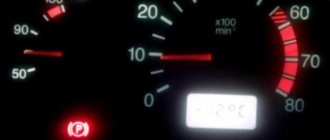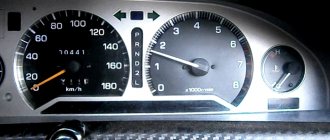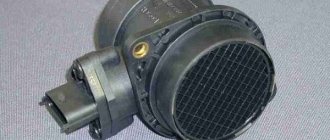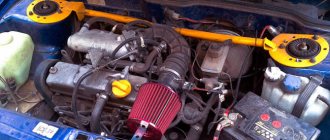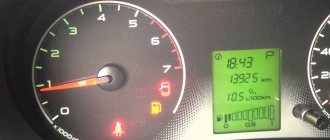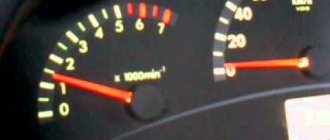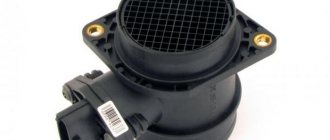During operation (especially long-term), motorists have to deal with the fact that the speed of the VAZ 2114 fluctuates. Frankly speaking, there can be several reasons for this unpleasant phenomenon - we will look at them a little lower. To begin with, it’s worth saying a few words about the idle speed itself.
Idle speed of VAZ 2114
A little about car idling
Idling refers to the operation of the power unit in a static position of the car, that is, when the car is stationary and the neutral gear is engaged.
When the engine operates this way, the load on it is negligible, and, therefore, fuel consumption is low. Idling is usually used to warm up the system in winter frosts in order to disperse the oil and prevent freezing. This mode is also used when it is impossible to turn off the motor.
During normal idling, the tachometer needle points to 2,000 rpm and slowly drops to eight hundred rpm. But, if there is a failure in the system, then the revolutions seem to live their own lives, sometimes soaring to incredible heights, sometimes falling to the very bottom.
In this case, the revolutions can fluctuate from a minimum of five hundred to a maximum of one and a half thousand revolutions per minute.
This happens especially often in new VAZ models equipped with an electronic pedal, E-gas, which, on the one hand, opens up new horizons for the driver, and on the other, gives him even more headaches in troubleshooting such fragile and unreliable electronic equipment.
It is worth saying that determining the true cause of an idle problem is not an easy process, but if you leave everything as is, it can lead to serious problems, which may result in a complete stop of the engine and the need for expensive repairs.
And now about all the problems and how to fix them in more detail.
The main reasons why engine speed fluctuates on a VAZ-2115
The car stalls while driving reasons
If everything is normal in the car, then you see the following picture. After the engine is started, the tachometer needle rises to approximately 2.5 thousand revolutions per minute. Gradually, as it warms up, it lowers. The range of 800-900 rpm is considered normal. However, it also happens that the arrow does not stay stable near the desired marks. It rises up and down - it seems as if the engine lives some kind of “life of its own”. In this case, the range of deviations is quite wide.
If you notice that your car's speed is fluctuating, then you need to start looking for the root cause as soon as possible. As mentioned above, this problem is quite unpleasant, and the sooner it is eliminated, the better. There are many reasons why engine speed starts to fluctuate, including in injection-powered cars. Their complete listing will take quite a lot of space, so we will limit ourselves to only the main ones.
Often the root cause of the problem is the failure of some sensor. A situation arises when the electronic control unit tries to read the information it needs, but cannot receive it. The consequence of this is precisely the incorrect operation of the engine, including floating speed. In a “tag” with an injection engine, the following main root causes of the problem can be identified:
- damage to high-voltage wires, including due to common wear and tear;
- faulty idle speed controller;
- candles - pollution, exhausted resource, low quality;
- Exhaust gas recirculation sensor malfunction;
- Incorrect operation of the mass air flow sensor.
You should also indicate one more, fairly common reason. We are talking about a banal entry into the air intake system from outside
However, the very first thing you should pay attention to when this problem occurs is the XX sensor
Checking its performance is quite simple. First of all, you should, of course, find the device - it is located near the sensor that controls the position of the throttle valve. Then take a multimeter and measure the resistance. If the indicators deviate in one direction or another from the permissible interval (40-80 Ohms), then we can state with almost 100% certainty that the root cause of the problem has been found.
If everything is in order here, then you should engage in further search. In particular, check the mass air flow sensor. This is quite easy to do. Disconnect the connector from this sensor, and then start the engine. If you do not notice any changes in its operation, then the problem is most likely in this sensor. This can be confirmed by slightly improved vehicle dynamics.
However, the cause of the problem is not always located here. This means we move on to the next stage - checking the functionality of the mass air flow sensor. Its task is to return a certain part of the burnt gases back into the chamber so that the fuel burns in full, and, accordingly, harmful emissions into the atmosphere are reduced. In this situation, simply cleaning the valve seat is often enough to solve the problem.
Quite often the speed starts to fluctuate due to problems with spark plugs or high-voltage wires. In the first case, a visual inspection will help. Candles should be carefully examined for carbon deposits. Also remember the last time you changed them, perhaps the reason was a banal resource exhaustion. The problem with high-voltage wires can be seen in the dark. If you see a firework of sparks there, replace them immediately. However, you can take a simpler route. You just need to take spark plugs or wires that are known to work, borrow them, for example, from someone you know, and install them on your car. First replace one thing, then another. If engine operation becomes normal, then the problem has been found.
Problems and solutions
There are a lot of reasons for unstable idle, and they apply to both carburetor and injection engines and even diesel engines, both to the old type design and to the new E-gas pedal, which AvtoVAZ is so proud of. Let's start with the problems that occur in carburetor-type engines:
- The fuel-air mixture has become lean. To fix the problem, you just need to make an adjustment to the level of eight hundred revolutions.
- Unstable running can also occur due to wear on the carburetor valve. In this case, the engine operates exclusively with the choke mode extended. To fix the problem, you need to replace the defective part with a new one.
- It also happens that the system channels become dirty. Then the fuel does not receive the required portion of air and leads to failure. Here you just need to clean the channels.
In the injection type of engine, there are no fewer reasons for failure.
- The first thing you can check is air leaks. Be sure to check the connection between the intake manifold and the cylinders to see if the gaskets are worn out. There are rubber plugs on the same manifold; if they are cracked, it is better to replace them. You can check all this by buying carburetor cleaner or any other flammable item in the store, start the car and spray all the joints, if there is a leak, the car will start to twitch, look in that place.
- They can cause gaps in speed and malfunctions in the IAC sensor (idle air control), it is often enough to remove it and clean it or inspect it for damage and replace it if necessary.
But problems with electronic equipment, in particular the famous E-gas, are much more complicated. Here it is observed:
- regulator failure (IAC);
- DMRV sensor failure;
- failure of the EGR valve (adsorber);
- damage to wires.
Types of malfunctions of the XX regulator on Priora
As mentioned above, such a part rarely fails, unless the car has a cheap fake. However, breakdowns of this device occur and, as a rule, this happens with the following defects:
- Slippage occurs when the worm gear of a stepper motor wears out. Slipping leads to the fact that the ECU is not able to set the required number of steps to open the channel to the required distance.
- Jamming - most often, the valve is blocked in the closed position. This happens when the driver turns on the ignition and the regulator is set to zero (in this case an electrical circuit malfunction or rod damage occurs). If the rod is jammed in the closed position, the car engine can only be started by pressing the accelerator pedal. If it is possible to start the engine in this way, then the cause is clearly a malfunction of the XX regulator.
- A stepper drive malfunction occurs due to a break in the stator winding circuit (one of the windings).
- Air leakage - there is a sealing gasket on the IAC housing that prevents the possibility of air leakage through the product body. If the gasket is damaged, this will lead to excess air entering, and as a result, there will be unstable speed.
- Rod play in axial and radial directions. If you have removed the IAC, and by manually moving the rod, it is found to be freely moving, then this is considered a serious malfunction. This malfunction usually appears while driving, when the gas is released and the engine is idling. Due to the presence of play, the rod is delayed in opening the XX channel, so the engine stalls. There should be no play either when it moves in the axial direction or in the radial direction. The presence of play indicates the need to replace the product, but cannot be repaired in any way.
- Damage to the IAC housing - this often happens when a non-original Chinese element is installed on a car. Engine vibrations cause damage to the rivets, and as a result, the regulator simply falls apart. Even if the product can be repaired by installing new rivets, it is not recommended to use it further.
- Clogged cone valve - often during the operation of the car, carbon deposits consisting of dust and oily substances form on the valve. Dust comes from the air duct when the air filter is not changed for a long time. Oily substances enter the throttle assembly along with crankcase gases. The likelihood that the IAC valve is dirty can be determined by the clogged damper. A valve with a large amount of contamination cannot be set to zero and ensure complete closure of the channel. In addition, contamination causes the rod to become distorted.
Most of the above faults can be identified visually. Failures in the electrical circuit can be determined using a multimeter. And we’ll find out further how to identify all kinds of regulator malfunctions on a Priora.
Idle speed regulator (sensor) VAZ 2114
At its core, the idle speed sensor is a valve equipped with a shut-off needle, through which the amount of air supplied to the combustion chambers bypasses the throttle valve is dosed. That is, when the damper is completely closed, and the controller comes to the conclusion that it is necessary to increase the idle speed, the idle speed controller (IAC) slightly opens or completely opens the intake port and thereby leans the fuel mixture. As a result, the car does not stall at idle even when driving on a cold engine. A stepper motor integrated into the regulator is responsible for driving the valve needle.
Women's reasons
This conditional category includes reasons that sometimes arise for people who are inattentive or do not service their car in a timely manner.
These include:
- Buying fuel at “left-handed” gas stations – this category also includes the purchase of cheap “grades” with various additives disguised under the names “E”, “ER” and others. It is not profitable for large chain gas stations to deceive customers, because selling normal fuel is cheaper than giving bribes to everyone, especially when it comes to the scale of the country, but the legislator does not prohibit selling some 95Er, with the alcohol content honestly indicated in the specifications. All drivers know about this, but greed takes over and such fuel kills the engine over time. The same situation has developed around “cheap underground” gas stations selling fuel siphoned off from truckers or military personnel.
- Dirty fuel and air filters - a symptom of this problem is when the VAZ 2114 stalls while driving or when you press the fuel pedal. Both filters are involved in the process of forming the fuel mixture, therefore, when the fuel one breaks, the gasoline supply is unstable, and if the air filter is used, the mixture becomes over-enriched, which in both cases leads to flooding of the spark plugs.
- Spark plugs - this car part can fail not only due to the reasons described above, but also due to age and improper care. Experienced car enthusiasts check spark plugs in VAZ cars at least once a month. To do this, you need to unscrew it with a spark plug wrench and evaluate the carbon deposits - the working spark plug has a light gray electrode and a light brownish carbon deposit. If the color is different, it's time to purchase a new set.
- Lack of fuel - everyone knows that it is better to drive on a full tank, but domestic motorists, due to the constant lack of money, the eternal crisis in the country and other similar reasons, prefer to drive on an almost empty tank and refuel only when absolutely necessary. At the same time, the accuracy of FLS on domestic cars is far from ideal and VAZ is no exception. Therefore, stopping at an angle, driving until the car stalls, topping up the tank on the road from a canister have a very negative effect on the fuel system, debris gets into it, and fuel is constantly supplied along with air.
- “Left” service stations - the saying “the miser pays twice” is most relevant when it comes to cars. Garage services, repairs from friends and other attempts to save money often turn into the fact that your VAZ 2114 injector does not idle, there are engine problems, and repairs need to be carried out at an official service center.
Tachometer with high speed
How to remove the idle speed sensor
Replacing the idle air control valve on a VAZ is very simple
To remove the sensor, you need to put the car on the handbrake and disconnect the negative terminal from the battery. Next, you need to disconnect the wiring harness from the sensor and clean the place where the IAC connects to the throttle pipe body - so that dirt and sand do not get into the mounting hole. The sensor is secured with two screws, which must be unscrewed with a screwdriver or ratchet.
Instructions for cleaning and lubricating IACs on Priora: detailed description of the process
In what case can a faulty idle air control regulator be repaired? Then, when this element is fully operational, and there is only contamination of the device rod. The cleaning procedure is not complicated and takes little time. To perform the cleaning procedure, you need to perform a number of the following manipulations:
- Remove the device from the car.
- Inspect his condition. The presence of play is unacceptable, and if such signs are detected, we immediately replace the product.
- If the rod needs cleaning, then it must be removed and the appropriate manipulations performed. The easiest way to remove the rod is to connect the power supply to it and turn on the ignition of the car. The rod will come out and simply separate from the rotor.
- Next, we evaluate the condition of the worm gear. If everything is in order, then clean the stem.
- Having cleaned the rod, we proceed to washing the inside of the rotor. To do this, we use kerosene, diesel fuel or WD-40, which needs to be used to treat the inside of the rotor. Carry out the procedure carefully so that liquid does not get on the stator winding, thereby damaging the insulation.
- After completing the above steps to clean the rod and seat in the rotor, you can lubricate it. Lubrication is needed to ensure smooth movement of the rod. To do this, we use regular Vaseline or technical lubricant for electrical devices. It is strictly contraindicated to use solid oil, litol, etc. Carefully lubricate the surface of the rod where there is a worm gear.
- It will not be superfluous to lubricate the bearing. To do this, we use a syringe with a needle and regular motor oil. Carefully lubricate the inside, and then proceed to the assembly stage.
- In order to install the rod in its place, it is recommended to additionally use a clamp. We screw in the rod, and after its threaded part is completely immersed in the rotor, it should be clamped in a clamp. We preliminarily control the position of the guides. After this, turn on the ignition. The rod will begin to move out and will automatically be pressed onto the rotor. Repeat the procedure several times until the rod in the extended position reaches a distance of 28 mm from the seat.
This completes the procedure for cleaning, lubricating and assembling the idle air regulator. It is suggested to watch a video where the author shows in detail how these manipulations are performed.
It is important to note that such manipulations with the IAC are recommended to be performed only in exceptional cases when the part can actually still serve. Otherwise, it is recommended to replace it immediately.
Replacing the sensor with a new one
As a rule, faulty idle speed sensors are not repaired - they are replaced with new ones, as recommended by the “manual” for the VAZ 2114. In this case, you must remember to clean the mounting hole with WD-40 or carburetor cleaner. You can immediately discard the O-ring from the old sensor, since the new one also comes with a new rubber band. By the way, it is recommended to lubricate it with engine oil before installing the sensor. It is also necessary to ensure that the IAC is installed correctly - as its predecessor was installed. After tightening the screws, you can connect the wires, connect the battery terminal and check the engine's performance at idle.
Diagnosing the injection system in the garage
The main factor in this process will be your luck, because very rarely when buying a car, motorists are interested in the brand of the ECU. Two types of brains were installed in the VAZ 2114, and the dashboards for the car were produced by Schetmash and the German VDO.
If you have the first option, you are out of luck; you will have to go to a car service center and contact a qualified specialist, but the owners of the second option are much more fortunate, because it is equipped with a self-diagnosis system.
VDO instrument panel
Diagnostics using the VDO panel is performed as follows:
- Turn off the ignition and hold down the odometer button.
- Then turn on the ignition and release the button.
- First, arrows will appear on the screen, after which you need to press 2 more times, after the first, information about the firmware will appear, and after the second, the error code itself.
- You can finish working with the panel, resetting the error, by holding the button until the countdown ends and 0 appears on the screen.
The error codes are as follows:
- 44.45 - lean/rich fuel mixture, respectively;
- 42 – problems with ignition;
- 33.34 – DMRV is faulty;
- 22, 23 – TPS requires replacement;
- 14.15 – coolant sensor problems;
- 1 – indicates that the ECU itself is faulty.
>Useful video
You can glean other interesting information on this issue from the video below:
How to replace IAC on a 1.6-liter injection engine
A feature of the maintenance of the 1.6-liter injection power unit installed under the hood of the VAZ 2114 is the somewhat difficult process of replacing the IAC.
Video about the reasons for the incorrect operation of the IAC
If on a one and a half liter engine everything is done literally in one breath - in accordance with the instructions above - then a more powerful engine requires more attention.
Replacement procedure:
- Remove the engine protective cover;
- Loosen the clamp securing the air filter pipe and disconnect the corrugation itself;
- Next, you need to unhook the throttle cable;
- By unscrewing two nuts 13, the entire throttle assembly is removed;
- To avoid getting into the engine once again, you can clean the throttle valve with carburetor cleaner;
- The wires are disconnected from the sensor, 2 screws are unscrewed;
- Installation of a new sensor and assembly are carried out in the reverse order.
Characteristics of the throttle position sensor
The purpose of the sensor is to regulate the volume of air flow that enters the motor. This air is used to form a flammable mixture.
Where is the sensor located in the car?
In order to diagnose the device if necessary, the car owner needs to know where the TPS is located. The controller is installed in the engine compartment. It can be seen on the side of the throttle line on the axis of the valve itself.
Controller location on the throttle
Device design
Structurally, the device includes the following:
- Controller housing. This component is made of heat-resistant fiberglass. The housing is equipped with two flanges, which are used to secure the controller to the throttle assembly.
- A connecting device equipped with three contacts. This component is integrated with the controller housing.
- A resistive device made of ceramic.
- Current collecting element. This component is designed to provide electrical contact with the resistive part.
- Collet clamp, equipped with a slot.
- Rubber gasket. Used to mount the controller on the axis of the throttle assembly.
Purpose of the throttle position sensor
The controller itself is responsible for correctly identifying the position of the valve on the throttle assembly. Its readings affect the operation of the fuel supply system. The power unit, in accordance with the device values, adjusts the volume of supplied gasoline under a certain operating mode. The TPS is used to convert the angular position of the throttle valve into DC voltage.
Features of the device:
- The data transmitted by the controller makes it possible to calculate the amount of damper opening. The information received by the control module ensures the calculation of the main control parameters of the power unit. Moreover, the data is determined taking into account the type of vehicle driving.
- The device itself is a potentiometer equipped with a current collector. The latter is used to move along a set sector radius, ranging from 0 to 80 degrees. When installing the device, the axis of this structural element must be connected to the drive of the throttle unit.
- The output resistance parameter of the potentiometer can change depending on the pressure on the gas pedal. Depending on its position, the degree of opening of the valve unit also changes.
- The controller is powered by supplying a stabilized voltage. The value comes from the control module and should be around 5 volts. A deviation of 0.1 V up or down is allowed.
Device technical parameters
Main technical properties of TPS controllers:
- The voltage to power the device is supplied to two pins - 1 and 2.
- The amount of resistance that forms between pins 1 and 2 ranges from 1.8 to 2 kOhm.
- The opening parameter for a fully closed node damper is from 0 to 2%.
- The voltage that is supplied to outputs numbered 3 and 2 when the damper is closed ranges from 0.25 to 0.65 volts.
- The valve opening value is more than 90 degrees.
- The voltage parameter supplied to pins 3 and 2 at full throttle ranges from 3.9 to 4.7 volts.
- The number of complete activation cycles of the device during its operation is at least one million.
- The calibration property of the dependence of the output voltage parameter on the rotation angle is linear. It is measured in the range from 0 to 100 degrees. The voltage ranges from 0.25 to 4.8 volts. The slope of the characteristic varies around 48 mV.
- The controller operating area parameter is in the linear range of the characteristic in the range from 10 to 90 degrees. This corresponds to the opening value of the unit damper at an angle from 0 to 100 degrees. The slope value varies around 39 mV.
Varieties
There are two main types of devices:
- Film-resistive sensors. This type of controller is usually installed standard during car production. The average service life of film-resistive devices is approximately 55 thousand km. But in fact, they fail more often.
- Contactless type of devices. Such TPS operate on the basis of a magnetic-resistive phenomenon, the Hall effect is used. The price of contactless sensors is higher, but their service life is long. These devices are more reliable and therefore rarely fail.
Andrey Seromolotov showed how a machine engine works with a contactless TPS.
Buy a new regulator or try to clean the old one - which is better?
If you are sure that the idle speed sensor is not working, you can try cleaning it. To do this, it is better to use WD-40 or carburetor cleaner. After disconnecting the wires from the sensor, simply clean the connector contacts using a cotton swab moistened with cleaner. It is also important to rinse the locking needle with an aerosol stream. This often helps, and the engine stops running at idle, and the car behaves normally at intersections and when braking for some more time.
We diagnose by eye and ear
The quality of such diagnostics greatly depends on the experience of the car enthusiast; a driver of the Soviet school simply learns more about the car by sound than some specialists by conducting computer diagnostics. Even if you are not a professional, you need to find the answer to just one question - when does the car stall?
The options may be as follows:
- at idle – there can be a lot of reasons, so it’s worth using a comprehensive check, starting with operational reasons and ending with the more serious ones described above;
- it stalls when cold, but works well when hot - in this case it’s worth checking the TPS;
- stalls after warming up - usually the cause is problems with engine maintenance, this creates problems with enriching the mixture at high speeds;
- It always stalls, but only works when the pedal is pressed - this is a breakdown of the DPKV. Characteristic symptoms are tripling, operation on two cylinders and inadequate knocking of valves audible even by ear;
- the engine stops working when braking or releasing the gas pedal - most likely the problems lie in a breakdown of the TPS, which disrupts the algorithms for supplying fuel to the engine when the speed decreases sharply;
- it starts and runs at idle, but stalls when the gas pedal is pressed to the floor - this is a characteristic feature of a MAF failure, the fact is that a broken sensor forces the same amount of air at high speeds as at idle.
By choosing your option, and then reviewing the list of reasons again, you can easily, if you don’t name the exact reason, then shorten the search list.
How much does it cost to repair an IAC at home?
Cleaning the idle speed sensor will help bring it back to life.
Despite the fact that the instruction manual for the “fourteenth” Lada does not recommend looking for an alternative to replacing the IAC, many people practice repairing the sensor with their own hands. To carry out restoration work, you need:
- remove the sensor, clean its body and pull out the 3 fixing pins (rivets);
- after this, you can carefully remove the case - so as not to disturb the solder spots of the wires;
- very often the cause of failure is a broken contact - in this case, you need to solder the wiring in place and cover the soldering area with varnish (to prevent corrosion);
- Another problem may be air leakage through the idle air sensor - to solve the problem, you can use a regular sealant, which will eliminate the gaps in the IAC housing;
- If it turns out that the needle guide drive or the guide itself is worn out, repairs will not be possible.
All repair options will require purely symbolic investments, as well as a minimum of time and experience of the performer.
Bottom line
The listed examples do not complete the list of possible reasons why the speed fluctuates when starting the engine. But they will certainly help you better understand your car, free you from fears of the unknown and, most importantly, from unnecessary costs for car services. Without knowing the principles of engine operation, we are often subject to cunning on the part of the auto mechanic. Sometimes cheap repairs turn into serious costs that can be avoided. Get to know your car better, and it will answer you with a satisfied and even purr.
- Next Car leasing for individuals: what is it?
- Back Alternator belt whistles: what to do and how to fix it
- Sep 4, 2019
- Sep 4, 2019
- Safety/Tips
Sep 4, 2019
- Audi crossovers / News
Sep 4, 2019
- Sep 3, 2019
- Sep 3, 2019
- April 13, 2019
- March 12, 2019
- Feb 17, 2019
- April 11, 2019
- News/Reference information
Jun 22, 2019
Price of a new sensor
The factory installed several IAC models on various versions of VAZ 2114 engines, although experienced mechanics say that all the regulators used in this case are interchangeable.
On VAZs, idle speed sensors are interchangeable
However, the manufacturer recommends replacement according to the following principle:
- 2112-1148300-01 - to a similar one or with number 2112-1148300-03 (“Pegasus”, Kostroma);
- 2112-1148300-02 - to a similar one or with number 2112-1148300-04 (KZTA, Kaluga).
The average cost of original sensors is 450-550 rubles.
Armored wires
When the speed of the VAZ 2114 fluctuates, it is worth evaluating the armored wires. First, we inspect them for visible damage, such as cracks, kinks, fractures. It is possible to determine interruptions in operation without special instruments; just look under the hood in the dark. If the wire is not working, a spark will be visible on it. You can also check the integrity using a multimeter:
- Turn on ohmmeter mode.
- Remove the wires from the cylinder and ignition coil one by one.
- Connect the tester electrodes to the ends.
Normal indicators depend on the brand of high-voltage wire. They are usually indicated on the braid. Also, the differences between the indicators should not be more than 2-4 kOhm.
If there is a malfunction in these two points, it is possible that there is a missing spark or it is weak, which is why the problem with floating speed arises.
Is there an IAC on modifications with an electronic gas pedal?
It should be noted that in the period from 2010 to 2013, version 211440-26 was produced, which came with the so-called electronic gas pedal. There is no IAC on this model. The idle mode in this case is controlled electronically. If on conventional injection engines with a mechanical accelerator pedal this function was performed by the idle speed regulator, here everything is managed by an electric throttle controlled by the ECU.
It is not uncommon for VAZ-2114 owners to encounter such a problem as unstable engine operation at idle speed. There are many reasons for this and diagnosis can be challenging. The most common such “sore” is the appearance of a malfunction of the idle speed sensor (regulator). Checking it and replacing it, thereby solving the pressing problem, is quite simple and this activity can be carried out with your own hands in the conditions of your own garage.
Reduced compression in the combustion chamber
The car engine must be clean and dry. Regular care of its surface will help you identify various leaks of working fluids in time, contact the workshop in time and prevent yourself from even greater expenses. It is especially useful to notice oil leaks in time. There can be several reasons for an oil leak. These include used oil seals, cover and pan gaskets, spark plug wells and many others. But we are looking at reduced compression, which is often associated with a damaged cylinder head gasket. Intense leakage of oil, pushed by pressure from the cylinder block, is visible on the surface of the engine.
Destruction of the gasket leads to unstable engine operation and can lead to more dangerous consequences, such as coolant getting into the oil, disruption of the block geometry, and even water hammer.
By promptly replacing a damaged gasket, you can protect your car from serious damage and keep it clean and dry.
Preparing for replacement: choosing a sensor and the necessary tools
Before you begin replacing the sensor, you need to carry out some preparatory measures. First of all, this is the purchase of a new spare part. You can find quite a lot of sensors on the market that are suitable for the VAZ-2114, but there are two of the most proven and affordable :
Idle speed sensor
- sensor from K3TA – marking: 2112-1148300-04 ;
- and a device from OMEGA - marking: 2112-114830 .
Important! When choosing, pay attention to the needle rod exit indicator; it should not exceed 23 mm.
You will need few tools for replacement. In most cases, it is enough:
- pairs of Phillips screwdrivers of different sizes;
- wrench size “13”;
- any unnecessary rag;
- lubricantsWD-40;
- and cleaner for carburetors or injectors.
Important! Use only clean tools that are in good condition. Otherwise, there is a risk of damaging the edges of the fasteners of some components that are removed during replacement.
Dirty throttle body
If the idle speed of a VAZ 2114 fluctuates, it is worth assessing the condition of the throttle. To do this, it must be removed from the car. If carbon deposits are found on the walls, it must be cleaned. It also has small channels that can become clogged much more easily and interfere with the normal operation of the unit.
To clean the throttle, use a special cleaner, which can be found in almost every car dealership. You can use carburetor cleaner. If the contamination is too strong, you need to soak the part in a clean container with gasoline and then clean it with a brush.
Features of the sensor
One of the features of determining a malfunction of the idle speed sensor on a VAZ-2114 is that the on-board computer is not able to recognize a breakdown in this unit.
Disassembled
With rare exceptions, it will display some errors (0505, 0506, 0507), but you should not rely on them alone, as they may indicate other malfunctions in the vehicle’s fuel system.
On-board computer readings
Due to this specificity of the work of the part, it is easier to pay attention to some signs that appear in the operation of the car and can help in diagnosis, more precisely:
- frequent spontaneous shutdown of the engine when idling;
- unstable (floating) idle speed;
- starting the engine “cold” is not accompanied by an increase in speed;
- turning off the gear at idle is accompanied by the fact that the engine stalls.
Sensor diagnostic methods
If such symptoms appear, you can finally make sure that it is the sensor that is faulty using a couple of proven methods:
- First. Remove the sensor and connect it to the system. Turn on the ignition, lightly touch the needle, it should seem to push forward. There are no shocks - the sensor is faulty.
- The second one is more reliable . Purchase a special tester to check the voltage and resistance in the electrical circuit. They need to check the voltage supply to the sensor; it must be at least 12 Volts. If voltage is supplied, but the problem still exists, it is advisable to check the sensor itself for operation. To do this, attach a tester to its paired terminals (AB and CD) and check the resistance, which should be about 53 Ohms. Then change the pairs to AC and BD - the resistance should be infinitely large.
Checking the resistance on the idle speed sensor
Important! If there is a deviation from the norm, the sensor is faulty. Of course, you can try to clean the terminals, contacts and check the condition of the electrical circuit, but often this does not produce results and replacement is required.
E-gas malfunctions
Sometimes the cause of malfunctions is a breakdown of the idle speed sensor on a VAZ 2114 with an electronic gas pedal, also called IAC. If the ECU indicates an error and the engine idle speed is too high and does not drop, mostly 2000, then the throttle assembly needs to be replaced, or you can try cleaning the terminal contacts.
Malfunctions of the electronic gas pedal of the VAZ 2114
If the electronic pedal is faulty and does not respond to pressing the accelerator pedal, and the engine speed is frozen at around 2000 rpm, do not despair and call a tow truck. With such a problem, you can move around, carefully releasing the clutch, slowly but surely you can get to your home or service center.
If you have some kind of malfunction related to the electronic gas pedal, then in the control unit you will most likely be able to find the following error codes:
- P2122 - indicates low voltage of the accelerator pedal position sensor. This sensor works on the principle of changing its resistance, and the ECU, passing current through it, recognizes it and, based on this, knows the position of the pedal. Low voltage corresponds to high sensor resistance. This can be solved by cleaning the contacts, soldering them, or replacing the pedal assembly if that doesn’t help.
- 2123 is the reverse error P2122, the voltage on the same sensor is too high. A breakdown or short circuit in the wiring, as well as failure of the sensor, is possible.
- 2127 – low signal level of the second accelerator pedal position sensor. Since this unit is quite responsible and performs an important function, it uses two sensors for accuracy and reliability. They are located in the same building, the sequence and methods for eliminating the error are the same.
- 2128 is a clone of error code 2123, only it is responsible for the second sensor.
- 2138 - the code indicates a discrepancy in the readings of these two sensors; perhaps contact has been lost with one of them or it has broken down. To solve the problem, you also need to clean the contacts, check the wiring for serviceability and test the pedal itself. The test consists of measuring the resistance of both sensors in different pedal positions and comparing the readings. If they are different, you need to change the pedal assembly.
Pinout e-gas vaz 2114
Nowadays, the electronic pedal has been worked on and most of the problems have been solved, now it works without failures, but fans of fast driving still flash their ECUs, noting improvements in the car’s response to the pedal.
This is primarily due to the fact that manufacturers are forced to impose restrictions from the factory in order to comply with EURO standards and increase engine life. Amateur firmware removes these restrictions, allowing the control unit to open the damper faster.
In Samara, and in particular with the electronic gas pedal of the VAZ 2114, problems were often encountered on models of the first years of production; after some time, the shortcomings were corrected and at the end of production, copies with reliable e-gas rolled off the assembly line.
If you find an error, please select a piece of text and press Ctrl+Enter.
Lambda probe
The sensor is responsible for measuring the amount of oxygen in the exhaust gases, which allows the engine control unit to regulate the amount of air supplied to the engine. When the sensor fails, uneven engine operation is noticed.
Diagnostics is carried out using a multimeter:
- One core of the device clings to the ground, the second to the output from the sensor;
- When re-gassing the engine, the readings should be in the range from 0.2 to 0.9 V;
Accordingly, when diagnosing a discrepancy, the device is faulty.
Mass air flow sensor
After IAC, the air flow sensor should be checked. In addition to problems with idle speed, the following symptoms will be detected: failures when pressing the gas, increased fuel consumption, loss of power. To diagnose the sensor, disconnect the chip from it, while carefully monitoring the operation of the engine. If it breaks down, an emergency operation mode is activated, which already includes average indicators. Therefore, if the engine operation does not change, this indicates a malfunction.
Try treating it with cleaner and putting it back in place. The sensor is sensitive and can malfunction at the slightest contamination.
Other breakdowns that cause interior vibration
But it’s not for nothing that the list of possible faults includes the item “Other technical flaws”. Just because some problems are more common than others doesn't mean they don't happen. That is why it is better to carry out a full diagnosis of the car when vibrations occur in the cabin.
Burnt-out diodes, pebbles and plants getting stuck in parts, friction of parts against each other, tilting of the engine and dents on the body - these are just a small part of those minor faults that can cause unpleasant trembling of the body and disrupt the operation of the engine. Fixing them doesn't take much time if you know how to do it yourself. A car service would not be the best solution. Once mechanics become aware of annoying vibrations, they may force you to replace already functioning parts.
Having bought a car, you should be prepared for the fact that you will have to learn how to understand it if you do not want to leave huge sums of money in car repair shops. This is especially true for VAZ, which likes to annoy drivers with all sorts of breakdowns, from slowly working wipers to body vibrations. You must always carefully monitor your vehicle if you do not want to stop in the middle of a busy road and cause a lot of inconvenience to others.
